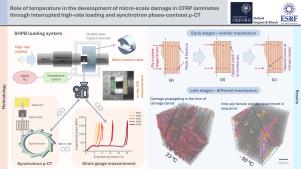Role of temperature in the development of micro-scale damage in CFRP laminates through interrupted high-rate loading and synchrotron phase-contrast µ-CT
IF 8.1
2区 材料科学
Q1 ENGINEERING, MANUFACTURING
Composites Part A: Applied Science and Manufacturing
Pub Date : 2025-09-17
DOI:10.1016/j.compositesa.2025.109284
引用次数: 0
Abstract
Understanding the evolution of damage in aerospace-grade CFRP composites after high-speed impact events is crucial for the safe design of components that can withstand dynamic loads. In this study, the temperature-dependent mechanisms of micro-scale damage in angle-ply CFRP were studied through a combination of interrupted high-rate compression experiments and synchrotron X-ray phase-contrast micro-tomography employing deep-learning-aided image analysis. Despite the earlier damage onset at low temperatures, all specimens tested have similar apparent-yield strains. The mechanisms responsible for the early damage, namely mode-II-dominant fracture in surface and subsurface plies, are observed to be similar at both low and room temperature, with the surface ply cracks the first to develop into opened damage. After the occurrence of the middle-ply opened damage, while the room-temperature specimens dissipate energy through deformation and cracking originating from the specimen loading ends, glassy inter-ply fractures propagating from the surface towards the middle plies are the root of the rapid drop in specimen strength at low temperatures after the apparent-yield point.

温度在中断高速加载和同步加速器相衬微ct下CFRP复合材料微尺度损伤发展中的作用
了解航空级CFRP复合材料在高速撞击事件后的损伤演变对于能够承受动载荷的部件的安全设计至关重要。在这项研究中,通过间断高速率压缩实验和采用深度学习辅助图像分析的同步加速器x射线相衬显微断层扫描,研究了角层CFRP微尺度损伤的温度依赖机制。尽管在低温下损伤发生较早,但所有测试的标本都有类似的明显屈服菌株。在低温和室温条件下,地表层和地下层的早期损伤机制(即ii型主导断裂)相似,地表层裂纹首先发展为开放性损伤。中间层开口损伤发生后,常温试样通过加载端产生的变形和开裂耗散能量,而从表面向中间层扩展的玻璃状夹层断裂是试样在明显屈服点后低温强度迅速下降的根本原因。
本文章由计算机程序翻译,如有差异,请以英文原文为准。
求助全文
约1分钟内获得全文
求助全文
来源期刊

Composites Part A: Applied Science and Manufacturing
工程技术-材料科学:复合
CiteScore
15.20
自引率
5.70%
发文量
492
审稿时长
30 days
期刊介绍:
Composites Part A: Applied Science and Manufacturing is a comprehensive journal that publishes original research papers, review articles, case studies, short communications, and letters covering various aspects of composite materials science and technology. This includes fibrous and particulate reinforcements in polymeric, metallic, and ceramic matrices, as well as 'natural' composites like wood and biological materials. The journal addresses topics such as properties, design, and manufacture of reinforcing fibers and particles, novel architectures and concepts, multifunctional composites, advancements in fabrication and processing, manufacturing science, process modeling, experimental mechanics, microstructural characterization, interfaces, prediction and measurement of mechanical, physical, and chemical behavior, and performance in service. Additionally, articles on economic and commercial aspects, design, and case studies are welcomed. All submissions undergo rigorous peer review to ensure they contribute significantly and innovatively, maintaining high standards for content and presentation. The editorial team aims to expedite the review process for prompt publication.
 求助内容:
求助内容: 应助结果提醒方式:
应助结果提醒方式:


